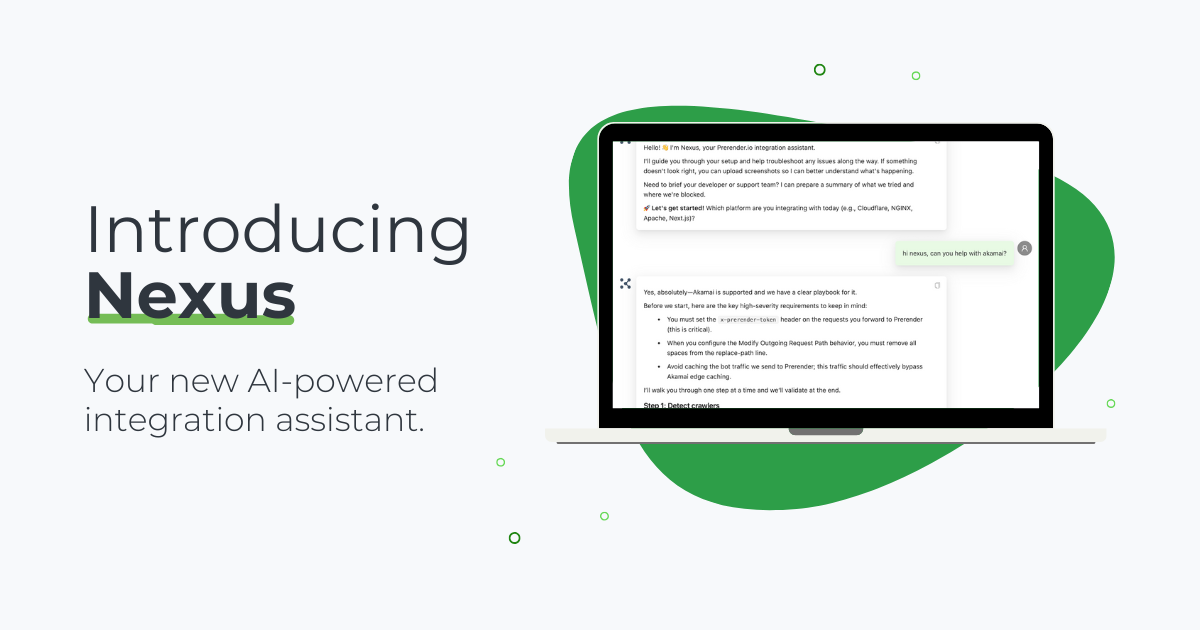Websites have their own unique identifying features, quirks, problems, needs, and no two are completely alike. In that sense, they’re a little like people.
For the same reason you might go to a doctor if you have a health problem, you go to a web developer or technical SEO expert if your website has technical SEO issues.
There are a few common problems that harm website rankings that often occur on many websites when they get big enough, old enough, or start to get enough traffic, and they need to be fixed for your business to succeed online.
In this blog post, we will discuss 20 of the most common technical SEO issues, and offer insight on how to find and fix them.
What is Technical SEO?
Technical SEO refers to the subcategory of SEO that is focused on the website’s structure and performance from a technical standpoint. This includes everything from how the website is organized to what the code is like under the hood.
When you ensure that your website is technically sound, Google can properly crawl and index your pages, which will help improve your website’s rankings and ultimately bring more traffic and customers.
🔍 Want to boost your SEO? Download the free technical SEO guide to crawl budget optimization and learn how to improve your site’s visibility on search engines.
Technical SEO is a notoriously complex and ever-changing topic, some common problems occur on most websites at some point.
The benefits of technical SEO are cumulative – a lot of little tweaks adding up to a big impact. While fixing just one might not have a noticeable effect, fixing many of them will improve your website’s overall value in a real way. Conversely, letting too many slip by unnoticed or go unfixed can get your website buried under your competitors in the SERPs.
Let’s take a look at the top 20 technical SEO problems that can harm your website’s rankings.
Problem 1: Your Website Isn’t HTTPS Secure
One of the most common technical SEO issues is a website that’s vulnerable to hackers, phishing schemes, and cybersecurity attacks. For your website to be considered secure, it needs to have HTTPS enabled. This is a type of security protocol that encrypts information sent from your website to the user’s browser.
Google gives a ranking boost to secure websites. If a website doesn’t have an SSL certificate, it will be marked as “not secure” in the browser. Users will take this as a sign that your website is neither safe nor trustworthy leading to a higher bounce rate and lower conversion rate.
You can tell if a website is secure if you type in your website’s URL and it starts with “HTTPS” instead of “HTTP.” If your website isn’t currently secured with an SSL certificate, you need to get one as soon as possible. You can purchase an SSL certificate from your web hosting company.
Problem 2: Your Website is Too Slow
A slow website can be a major hindrance to your business. 47% of users expect a website to load in two seconds or less. If your website takes longer than three seconds to load, you could be needlessly losing customers and sales.
Page speed is also a major ranking factor for Google and other search engines. This means that if your website is slow, it could be negatively impacting your visibility in the SERPs.
There are several online tools that you can use to fix page speed issues, such as Google PageSpeed Insights and WebPagetest. Once you know your website’s page speed, you can start working on improving it since Google PageSpeed Insights gives you an action item list of things you can do to improve its speed. These include large image files, unoptimized code, and too many plugins or scripts.
If you want to delve deeper, waterfall in Chrome DevTools will allow you to dig into the inner workings of your website to see what unused code or script files are bogging it down.
Problem 3: Your Website Isn’t Displaying Properly on Smart Devices
In recent years, there’s been a shift in how people access the internet. More and more people are using their smartphones and tablets to surf the web. Over 60 percent of Google searches are now done on mobile devices. In response to this, Google is making the full transition over to mobile-first indexing in 2022.
This means that it’s more important than ever to have a website that displays properly for mobile phones. If your website isn’t optimized for mobile devices, you could be losing out on a lot of traffic and revenue.
You can test your website’s mobile friendliness with Google’s Mobile-Friendly Test. This tool will analyze your website and tell you if it’s properly optimized for smaller screen sizes.
One of the best ways to make your website mobile-friendly is by using responsive design, which will make your web pages automatically adjust to fit any screen size.
You can also use Google’s AMP (Accelerated Mobile Pages) framework to create a mobile-friendly website. AMP is an open-source project that allows you to create websites that are designed specifically for mobile devices.
Problem 4: You Have Too Many 301 Redirect Chains and They’re Confusing Search Engines – AND Your Customers
301 redirects are a useful way to keep your website’s URL structure intact when you make changes to your website, like if you change your website’s domain name, or if the content gets refreshed or updated.
However, as a website gets bigger and has more content added to it, 301-redirects tend to get stacked on top of one another, with URL A leading to URL B then to URL C, and so on. This is known as a 301-redirect chain.
These can be very harmful to your website’s SEO health if left unchecked. This is because each time a visitor lands on a page with a 301 redirect, they have to wait for the server to send them to the new page. This can add a significant amount of time to your website’s load time.
Too many 301 redirects can also confuse search engines. If a search engine crawls a website with a lot of 301 redirects, it can get lost and not index all of the pages on your website. You will exhaust the crawl budget that Google allocates to your website and potentially lead some of your pages to go unindexed.
SEO web crawlers like Screaming Frog and similar tools can check for 301-redirect chains – where they originate from and where they lead to. You can clean them up by using a redirect mapping tool to identify which redirects are unnecessary and can be safely removed, pointing them directly to the end destination URL. You can also remove the pages with the 301 redirect status from your sitemap.
Problem 5: Your Website Isn’t Being Indexed Correctly
If your website isn’t being indexed correctly, it won’t show up in search results at all, so users will be unable to find your website in the first place. There are a few different ways to check if your website is being indexed correctly. The first way is to use the Google Search Console. This tool will help you track your website’s search engine visibility and indexing.
Another way to check if your website is being indexed correctly is to do a manual search on Google. Do a site query by typing “site:yourdomain.com” and Google will show you all of the pages on your website that are being indexed.
The best way to make your website indexable is to submit a sitemap to Google. A sitemap is a file that contains a list of all of the pages on your website. You can submit your sitemap to Google through the Google Search Console.
Another way to fix this SEO problem is by adding structured data to your website. Structured data is code that helps search engines understand the content on your website – what it’s for, and what it’s about. You can add structured data to your website with the help of a plugin or by manually adding it to your website’s code.
Problem 6: Your Robots.Txt File is Missing or Broken
The robots.txt file is a text file that tells search engines which pages on your website they should index and which they should ignore. This file is located in the root directory of your website.
If your robots.txt file is missing or broken, it can cause search engines to index all of the pages on your website, even the ones that you don’t want to. It can also result in a site overloaded with requests and may even block important pages from being indexed.
You can check to see if your robots.txt file is present by typing your URL into Google and then adding ‘/robots.txt’ at the end. If you see a list of your website’s pages, it means that your robots.txt file is working correctly. If you don’t see any pages, it means that your robots.txt file is missing or broken. Also, if the results show ‘User-agent:*Disallow’, it means that your website is blocking access to robots, which is not what you want.
To fix a missing or broken robots.txt file, you need to create a new one and upload it to your website. The robots.txt file is a very simple text file, so you can easily create one yourself or hire a web developer to do it for you.
Problem 7: Your Website Has Duplicate Content – Multiple Versions of the Same Page
Having duplicate content on your website is an absolute SEO nightmare and can be very hard to recover from. Duplicate content causes search engines to penalize your website for having multiple versions of the same page. This can lead to a drop in your website’s search engine rankings and a loss of traffic.
One way to check for duplicate content is to do a manual search on Google. Type in “site:yourwebsite.com” and Google will show you all of the pages on your website that are being indexed. If you see multiple versions of the same page, it means that you have duplicate content on your website. You can copy some text from your content and paste it into Google Search within quotations. This will show you all of the web pages that are using your text, including yours.
The best way to fix duplicate content is to consolidate your web pages using the rel=canonical tag. This means that you need to tell the search engines which version of the page you want them to index. You can do this by adding a ‘rel=canonical’ tag to the head of your page. You can also opt to redirect the duplicate content to the original content.
Problem 8: Your Backlinks Come from Spammy or Insecure Websites
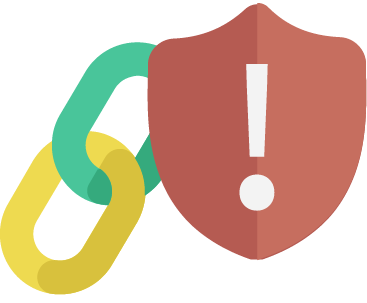
Receiving backlinks is always the goal of any SEO campaign. However, not all backlinks are created equal. Receiving backlinks from spammy or insecure websites can hurt your website’s search engine rankings.
The best way to check the quality of your backlinks is to use a backlink SEO checker. It will help you track your website’s search engine visibility and indexing. It will also show you all of the websites that are linking to your website.
If you see any spammy or suspicious-looking websites, it’s best to disavow them. This means that you need to tell Google not to take those backlinks into account when they’re ranking your website. You can do this by using the Google disavow tool.
Problem 9: Using Soft 404 Errors On Your Website
A soft 404 error is when a page returns a ‘404 not found’ error but the content of the page is still there. This means that the search engines will index the page, but when someone clicks on the link, they’ll get a 404 error message instead of the content they were looking for.
The best way to check for soft 404 errors is to use Google Search Console. This tool will help you track your website’s search engine visibility and indexing. It will also show you all of the pages on your website that are returning a 404 error message.
When you find the soft 404s, the best fix is to redirect them to a working page only on our website. This will ensure that your visitors get useful content instead of a 404 error message.
Problem 10: Your Title Tags are Truncated in the SERPS
Your title tags are one of the first things that a user sees when they come across you on Google. They are what show up in the search engine results pages (SERPS) and they help to determine your website’s click-through rate (CTR).
However, if your title tags are too long, they will be truncated in the SERPS instead of displaying the full title. This makes for a poor user experience which can hurt your web page’s click-through rate.
The best way to fix this is to shorten your title tags. You can do this by adding the most important information like your primary keyword at the beginning of your title tag. You should also use less than 60 characters so that they will be fully displayed.
Problem 11: Your Meta Descriptions are Missing or Pre-filled
Meta descriptions are another important element of your website. They’re the short snippets of text that show up under your title tag in the SERPS.
If your meta descriptions are missing, it can lead to a decrease in your website’s click-through rate and a loss of traffic. If they’re prefilled with the content Google provides, it can look unprofessional.
The best way to fix this is to make sure that your meta descriptions are unique and relevant to your website’s content. They should also be less than 160 characters so that they will be displayed in their entirety in the SERPS. Also, never forget to include your primary and secondary keywords in your meta descriptions.
Problem 12: Your Website Has an Incorrect Rel=Canonical Tag
If you have duplicate content on your website, you can use the rel=canonical tag to tell the search engines which version of the page you want them to index. However, if this tag is incorrect, it can make the duplicate content problem even worse.
The best way to fix this is to make sure that the rel=canonical tag is correctly implemented on all of your pages. You can do this by using an SEO tools canonicalization tool. It will help you track your website’s search engine visibility and indexing and which has the canonical tag.
Related: How To Fix Duplicate Content Issues
Problem 13: Your Pages Have Broken Links
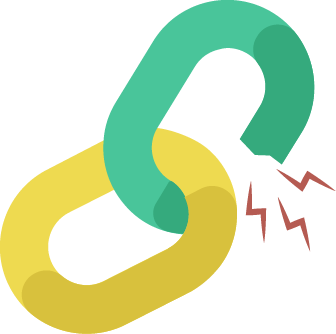
Broken links are links that lead to pages that no longer exist. They can be caused by a change in your website’s URL structure, by deleting pages, or by moving pages to a new location.
If you have broken links on your website, it can lead to a decrease in your website’s search engine rankings. It can also cause your website visitors to leave your website.
The best way to fix this is to use a broken link SEO checker such as Google Analytics. It will help you track your website’s search engine visibility and indexing. It will also show you all of the broken links on your website.
Once you have identified the broken links, you can either delete them, redirect them to the correct page or change it to a valid one.
Problem 14: Your Website Doesn’t Use Structured Data
Structured data is code that helps the search engines understand the content on your website. It can be used to mark up things like articles, events, products, and people.
If your website doesn’t use structured data, it can lead to a decrease in your website’s search engine rankings.
The best way to fix this is to add structured data to your website. You can do this by using an SEO tool’s Structured Data Markup Helper. It will help you mark up your website’s content with the correct schema type.
Once you have added the structured data, Google will be able to understand it and index it correctly.
Problem 15: International Versions of Your Website Send Users to Pages With the Wrong Language
If someone from a different country tries to visit your website, they may be sent to the wrong version of your website.
If this happens, it can lead to a decrease in your website’s search engine rankings. It can also an overall decrease in user experience and boost the bounce rates.
To pinpoint this issue you’ll have to check all of the pages to make sure they’re optimized for the right language.
Then, you can use a hreflang tag to indicate to Google which language versions of your website are equivalent. You can also set up redirects so that if someone visits the wrong version of your website, they will be automatically redirected to the correct version. Or you can install a language switcher so that visitors can choose the language they want to see.
By doing this, you can improve your website’s search engine rankings and user experience.
Problem 16: There’s No Alt-Text In Your Images
The alt-text is the text that appears when an image can’t be displayed. It helps the search engines understand what the image is about. It also helps people who are visually impaired understand what an image is.
A website without alt-text can cause a small but nonetheless troublesome rankings drop, and it can also make it difficult for people with disabilities to use your website.
To check if you’re having this issue, use a screen-reader tool and select an image. The alt-text should be read out loud. If it’s not, then you need to add the alt-text to that image. You can also examine the image using the inspect tool, where you can see the alt-text in the source code.
Once you have found the images, add alt-text to them using the image settings from within your CMS.
Problem 17: Your Backlinks Are Lost or Broken
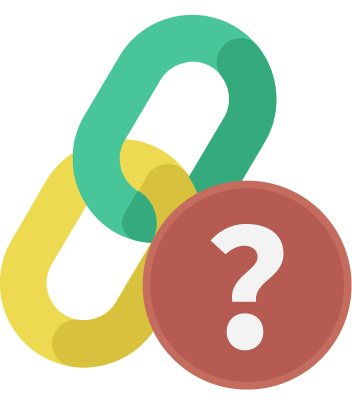
Broken or lost backlinks are bad for your website. They can lead to a decrease in your website’s search engine rankings.
You can use a backlink analysis tool like Ahrefs’ broken backlinks report to identify all the lost or broken backlinks leading to your website, as well as their domain rating and referral traffic.
Once you have identified the lost or broken links, you can either delete them, redirect them to the correct page or change it to a valid one.
Problem 18: Your Website Doesn’t Have an XML Sitemap
An XML sitemap is a file that contains all of the pages on your website. It helps the search engines understand your website’s structure, where everything is, and what it does.
If your website doesn’t have an XML sitemap, it will be hard for Google to find and crawl your web pages effectively.
To create an XML sitemap, you can use an SEO tool such as Google Search Console or Screaming Frog. It will help you create and submit your XML sitemap to the search engines. You can also choose to hire a web developer to create and submit your XML sitemap for you.
Once you have created the XML sitemap, the search engines will be able to find and crawl, hence improving your website’s search engine rankings.
Problem 19: Google Can’t Render Your JavaScript Content
Web pages that are made using JavaScript frameworks take extra processing power for Google to render and index. This can cause you to exhaust your crawling budget before all your pages can be indexed, causing them to not show up on the SERPs at all.
You can solve this issue by using a tool such as Prerender that will not only make sure your JavaScript website is rendered in static HTML that search engines can read.
Experiencing sudden drops in traffic? It might not be a core update. Yup, poor JavaScript rendering can cause this too.
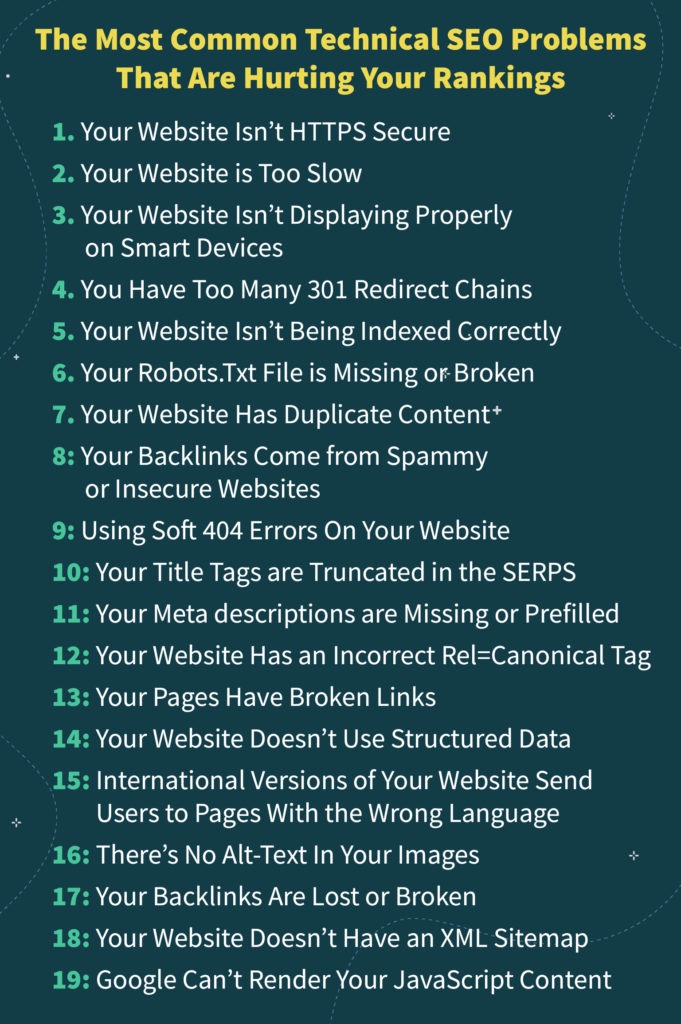
Fix Your Website’s Technical SEO Issues
The process of understanding how to fix any SEO issues like these is long, tough, and complicated. However, when you nip these problems in the bud and do routine website maintenance thereafter, you can make these issues manageable before they snowball out of control.
Prerender offers fast and reliable JavaScript rendering services to resolve any Javascript issues you may have. Sign up for 1000 free renders today and bring out your website’s fullest potential.

